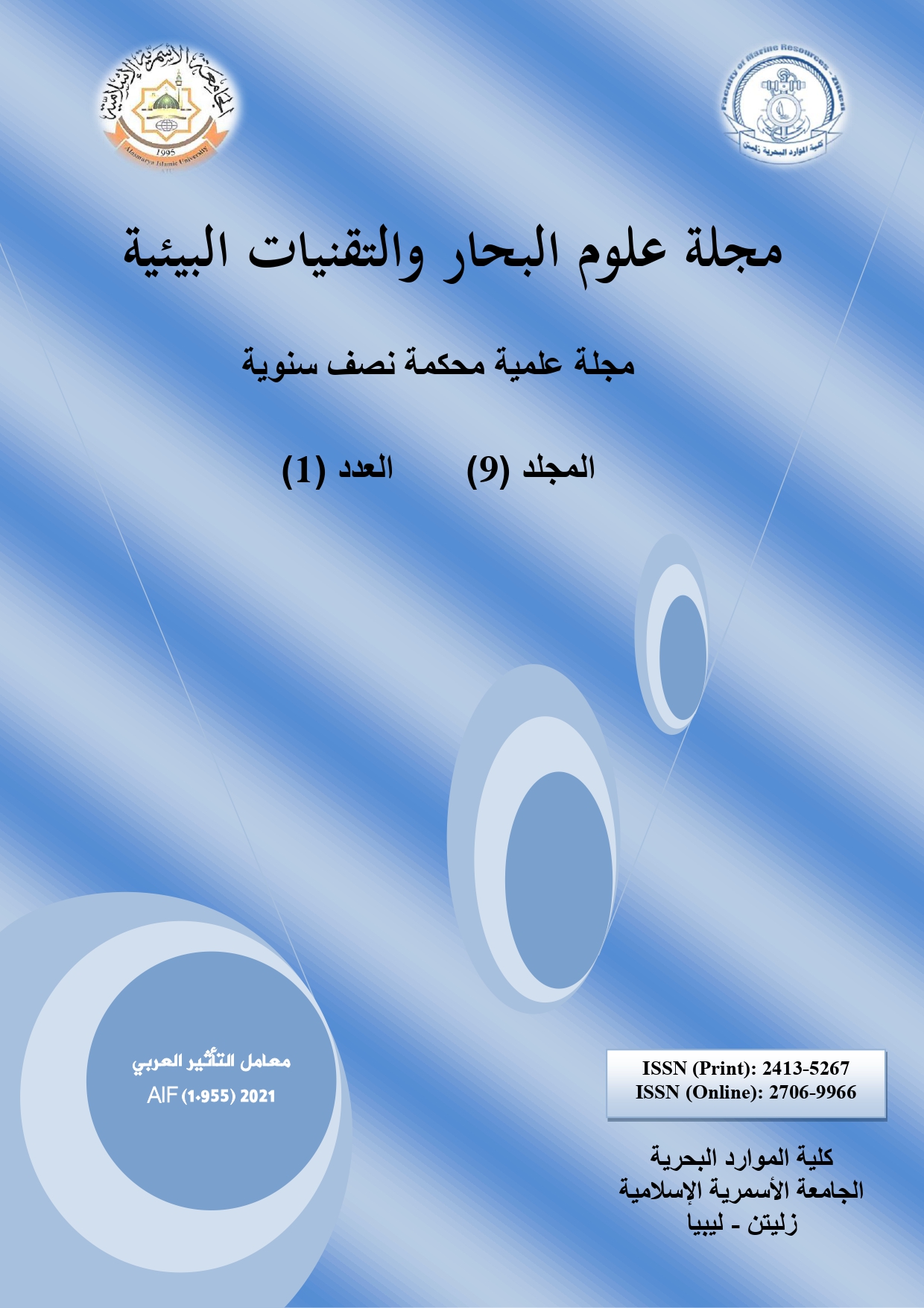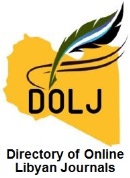تقييم تلوث الهواء في مدينة بنغازي خلال فترتي فبراير ومارس باستخدام محطة قياس جودة الهواء الثابتة
DOI:
https://doi.org/10.59743/jmset.v9i1.147الكلمات المفتاحية:
مؤشر جودة الهواء، العوامل الجسيمية (PMs)، بارامترات الأرصاد الجوية، مدينة بنغازي، شمال شرق ليبياالملخص
الجسيمات هي مؤشر رئيسي على مستوى تلوث الهواء. تحدد نسبة الجسيمات الدقيقة والخشنة ونوع الجسيمات قدرة العمليات الجوية وتؤثر على صحة الإنسان. الهدف من هذا العمل هو تقييم التباين الزماني المكاني للجسيمات (PM1 وPM2.5 و PM10) خلال فترة المراقبة من فبراير 2023 إلى مارس 2023 وتقييم الارتباطات بين الملوثات وتأثير عوامل الأرصاد الجوية. أظهرت النتائج أن المتوسط الرئيسي لمؤشر جودة الهواء (AQI) في فترة فبراير حوالي 138 ميكروجرام/م3، مما يعكس أن جودة الهواء غير صحية للمجموعات الحساسة، في حين بلغ المتوسط الرئيسي لـ AQI في فترة مارس حوالي 89 ميكروجرام/م3، مما يعكس جودة الهواء بشكل معتدل. استنادًا إلى نسب PM2.5/PM10 في فبراير، تكون الجسيمات المختلطة والمصدر البشري أكثر شيوعًا في الغلاف الجوي ونسب PM2.5/PM10 في فترة مارس، تكون الجسيمات المختلطة والمصادر الطبيعية أكثر شيوعًا في الغلاف الجوي في مدينة بنغازي. تحتوي فترة فبراير على ملوثات أكثر من فترة مارس بسبب تأثرها بأكثر من نوع من التلوث. كانت المخططات القطبية ثنائية المتغير لدرجات الحرارة AQI وPM1/PM2.5 وPM2.5/PM10 مرتبطة سلبًا بدرجة الحرارة بينما كانت مرتبطة بشكل إيجابي بسرعة الرياح. اتجاهات الرياح الجنوبية الشرقية لها تأثير كبير على زيادة تركيزات الجسيمات الدقيقة والتلوث الطبيعي في مدينة بنغازي.
التنزيلات
المراجع
Alias M., Hamzah Z., Kenn L.S. (2007). PM10 and Total suspended particulates: measurements in various power stations. The Malayasian Journal of Analytical Sciences, 11(1): 255–261.
Alhadi A.A., Mohamed A.E., Abdulsalam M.A., and Mokhtar H.A. (2107). Ozone Concentrations in Tripoli City Atmosphere, Libya. Journal of Marine Sciences and Environmental Technologies, 1(2): 1-12.
Busheina I.S., Kammashi M., Etorki A.M., and EL-Rouissi R.H. (2107). Assessment and Measurement of Atmospheric Pollution (Particulate Matter) around Zawiya City-Libya. Environmental & Analytical Toxicology, 7(4): 1-4.
Farooq U., Bahadar Z., Khan A., Mohammad V., Allah D., Armin S., Rana R., Iftikhar A., and Rashid I. (2022). Exploring the Mass Concentration of Particulate Matter and Its Relationship with Meteorological Parameters in the Hindu-Kush Range. MPDI, 1-13. DOI: https://doi.org/10.3390/atmos13101628
Hao F., Chuanfeng Z., Yikun Y., and Xingchuan Y. (2021). Spatio-Temporal Variations of the PM2.5/PM10 Ratios and Its Application to Air Pollution Type Classification in China. Frontiers in Environmental Science, 9: 1-13. DOI: https://doi.org/10.3389/fenvs.2021.692440
IQAir (2023). Air quality in Libya. Available online at: [https://www.iqair.com/Libya].
Kong L., Xin J., Zhang W., and Wang Y. (2016). The Empirical Correlations between PM2.5, PM10 and AOD in the Beijing Metropolitan Region and the PM2.5, PM10 Distributions Retrieved by MODIS. Environ. Pollut. 216: 350–360. DOI: https://doi.org/10.1016/j.envpol.2016.05.085
Li Y., Chen Q., Zhao H., Wang L., and Tao R. (2015). Variations in PM10, PM2.5, and PM1 in an urban area of the Sichuan Basin and their relation to meteorological factors. Atmosphere, 6: 150–163. DOI: https://doi.org/10.3390/atmos6010150
Lin J., Liu W., and Yan I. (2009). Relationship between meteorological conditions and particle size distribution of atmospheric aerosols. J. Meteorol. Environ., 25: 1–5.
Milad F. (2018). Air Pollution and the Environmental Factors and Risks Resulting from it. Global Libyan Journal, 35: 1-24.
Munir S., Habeebullah T.M., Seroji A.R., Morsy E.A., Mohammed A.M.F., Saud W.A., Esawee A.L., Awad A.H. (2013). Modeling particulate matter concentrations in Makkah, applying a statistical modeling approach. Aerosol Air Qual. Res., 13: 901–910. DOI: https://doi.org/10.4209/aaqr.2012.11.0314
Osama R.S., Fares F.F., Namat M.H., Hwedi E., Farag M.EL., and Saad K.E. (2017). Carbonaceous Particles in the Air of Two Urban Environments (Tobruk and Emsaed) in Libya. 22nd International Transport and Air Pollution Conference. Proceeding Book, 53-59.
Sami H.A., Mussa M.A., Yasmin Y.M., and Eman N. Z. (2020). Determination of Aerosol Metals Pollutants in Falling Dust in Benghazi City, Libya. Journal of Environmental Analytical Chemistry. 7(3): 1-16.
Shaddick G., Thomas M.L., Mudu P., Ruggeri G., and Gumy S. (2020). Half the world’s population are exposed to increasing air pollution. NPJ Clim. Atmos. Sci., 3-23. DOI: https://doi.org/10.1038/s41612-020-0124-2
Tian P., Zhang L., Ma J., Tang K., Xu L., and Wang Y. (2018). Radiative Absorption Enhancement of Dust Mixed with Anthropogenic Pollution over East Asia. Atmos. Chem. Phys., 18(11): 7815–7825. DOI: https://doi.org/10.5194/acp-18-7815-2018
U.S. (2014). Environmental Protection Agency, Office of Air Quality Planning and Standards Outreach and Information Division Research, Triangle Park, NC, p.12.
Yasser F.N., Kaiss R.A., and Samer Y.A. (2018). Air Pollution Sources in Libya. Journal of Ecology and Environmental Sciences, 6(1): 63-79.
Wu F., Wang W., Man Y.B., Chan C.Y., Liu W., Tao S. (2015). Levels of PM2.5/PM10 and Associated Metal(loid)s in Rural Households of Henan Province, China. Sci. Total Environ., 512-513: 194–200. DOI: https://doi.org/10.1016/j.scitotenv.2015.01.041
Zhou X., Cao Z., Ma Y., Wang L., Wu R., and Wang W. (2016). Concentrations, correlations and chemical species of PM2.5/PM10 based on published data in China: Potential implications for the revised particulate standard. Chemosphere, 144: 518–526. DOI: https://doi.org/10.1016/j.chemosphere.2015.09.003
التنزيلات
منشور
إصدار
القسم
الرخصة
الحقوق الفكرية (c) 2023 مجلة علوم البحار والتقنيات البيئية

هذا العمل مرخص بموجب Creative Commons Attribution 4.0 International License.












